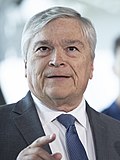| Term | President | Background and accomplishments |
|---|
First
1887–92 |  | George Edgar [3] |
Second
1892–97 |  | Alvin Lewis |
Third
1897–09 |  | Albert A. Murphree [3] |
Fourth
1909–41 |  | Edward Conradi [3]
|
Fifth
1941–57 |  | Doak S. Campbell [3] |
Interim
1957 | | Albert B. Martin |
Sixth
1957–60 |  | Robert M. Strozier [3] |
Interim
1960 |  | Milton W. Carothers |
Seventh
1960–65 |  | Gordon W. Blackwell [3] Resigned as FSU President in 1965 after five years to become President of Furman University. |
Eighth
1965–69 |  | John E. Champion [3] Resigned as FSU President at age 47 in 1969 after 4 years; returned to teaching Business for 15 years as Professor Emeritus. |
Ninth
1969–76 |  | J. Stanley Marshall [3] Resigned in 1976 at age 53 after 7 years as FSU President; Security Company president for 10 years, then founded James Madison Institute. |
Tenth
1976–91 |  | Bernard F. Sliger [3] Retired as FSU President after 15 years at age 67; remained a presence at FSU for many years. |
Eleventh
1991–94 |  | Dale W. Lick was FSU President less than three years, leaving after losing support from faculty, legislators and influential alumni. |
Twelfth
1994–03 |  | Talbot D'Alemberte [3] Retired as FSU President after nine years at ago 70. He continued to teach and litigate until his death in 2019. |
Thirteenth
2003–10 |  | T. K. Wetherell [3] The first FSU graduate to serve as president, he resigned after seven years on January 31, 2010 due to complications from cancer. |
Fourteenth
2010–14 |  | Eric J. Barron [3] After four years at FSU he resigned on April 2, 2014 to accept the position of President at Pennsylvania State University. |
Interim
2014 | | When Eric Barron resigned as president on April 2, 2014, Provost Garnett S. Stokes served as acting president until November 10, 2014, when John Thrasher became president. |
Fifteenth
2014–2021 |  | John E. Thrasher [3] retired at age 78 after almost seven years as president and returned to his old law firm. |
Sixteenth
2021–Present | | Richard D. McCullough, a graduate of the University of Texas and Johns Hopkins University, is the university's 16th president. He assumed office Aug. 16, 2021, succeeding President ·John E. Thrasher. |

















